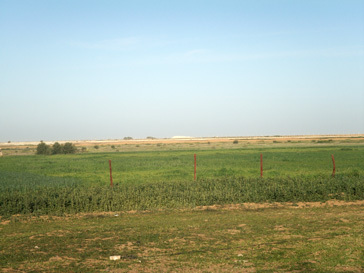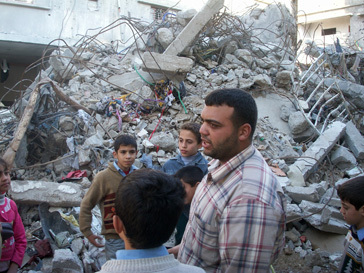Tuesday 10th February saw the first real rain in Gaza since the supposed “ceasefire”. Whilst most of Palestine is desperate for rain, it was bad news for the people sleeping in tents in the newly-constructed emergency shelter camps – as most of the tents are of simple triangular design without proper flooring or annexes in which to shelter. Despite the fact that approximately 100 000 Palestinians made homeless by 22 days of ceaseless aerial and land attacks, the numbers of people actually sleeping in the 10 camps throughout the Gaza Strip are not high. The reason is at once simple and staggering: there are not enough tents.
So thorough-going is the Israeli siege on Gaza, that there are, roughly, only enough tents throughout the Strip for approximately one in every 10 families. The rest are held outside, stock-piled at border crossings, waiting for the siege to be eased.
Rather than employing discriminatory allocation systems, tents are being assigned to multiple families – as in the case of the Karama (Dignity) camp in Izbit Abed Rabbo, where the 350 families who had
their homes completely destroyed share just 55 tents. Each 2 x 3m tent is assigned to 7 families (approximately 50 people) – not counting the further 350 families whose houses were badly damaged.
The result of this shocking deficiency is, simply, that few people are sleeping in the tents. The majority, explains Mustafa, a coordinator of Karama camp, are staying with host families – friends and
relatives. The camp will be full during the day, as families utilise the shared space, but then the majority of homeless families will leave in the afternoon to go back to the houses where they are hosted
to sleep. Some men will sleep in the camp, he explains, and occasionally older women will sleep there with their husbands.

Women from Izbit Abed Rabbo utilise Karama (Dignity) camp during the day
Whilst the main factor in this pattern of usage is the lack of tents, other factors play a role as well. One important factor is security. ‘The security and infrastructure doesn’t allow for people to stay here’, Mustafa explains. ‘There was shelling nearby two days ago [7th January] – tanks were advancing and we had to abandon [welfare] distribution’.
Another factor is the general lack of facilities and amenities. Whilst most camps have been able to establish basic toilets, using zinc and wood, there are few other facilities available. Most camps have no
cooking facilities (not even enough to brew tea or coffee); no bathing facilities; and lack even mattresses and blankets. On average, camp coordinators advise, two mattresses and one blanket have been supplied for every family. Issa, a coordinator of the nearby “Samoud” (Steadfastness) camp, who is himself homeless after his house was
destroyed, notes that this was the ration supplied to his 19 person family. Resultingly, the camps are too cold to sleep in. Tawfiq, a coordinator from the Kamal Adwan camp in Beit Lahiya (named for the hospital it is situated near), echoes this sentiment. ‘At night it is full of men sleeping here, but there are no mattresses or blankets. It is too cold and windy. You can’t bring children here’.
The lack of supplies is not due to a lack of will or budget on the part of organisations that are working on relief aid in Gaza – such as United Nations Relief and Works Agency (UNRWA); International Committee of the Red Cross (ICRC); United Nations Development Program (UNDP); Unicef; and other smaller, local organisations. It is again a
matter of lack of resources, due to the Israeli siege. Whilst truckloads of blankets and mattresses have been allowed through the border crossings, they are not nearly sufficient for the huge numbers of people rendered homeless by the attacks. Especially, given the fact that the vast majority of those whose houses were destroyed were forced to flee with just the clothes on their backs – often without even shoes. ‘In most instances drones would drop a missile on the
house, which would be the warning. Then an F-16 strike would follow’, recalls Tawfiq. ‘Most [families] weren’t able to take anything – no cash, no ID, nothing’.

Karama camp - built amongst the devastation of Izbit Abed Rabbo
Many of the camp coordinators – volunteer groups that range from teams of charity workers, such as in Karama camp; to teams 100-strong of local community volunteers, such as in Kamal Adwan camp – go to
lengths to explain the way in which the siege impacts on their abilities to administer relief and humanitarian aid in the camps. Beyond just infrastructural constraints, camps are at a loss to provide even food for Gaza’s new homeless. In Karama camp, just one food package, consisting of rice; lentils; beans; sugar; and a small jar of tahina, has been provided for each family. Other camps have received no food at all. The failure of aid and relief organisations
to provide material assistance is described as being ‘deeply troubling’ for people, according to Karama camp’s organisers. Particularly, the failure to distribute basic foodstuffs, such as bread, on a daily basis, has been extremely upsetting. In each camp, it is reiterated, that this is not due to a lack of donations, but an inability to get these donations through the border crossings. Indeed, according to John Ging, director of operations for UNRWA in
Gaza Strip, UNRWA is currently only permitted to bring in enough supplies each day to feed 30 000 of the 900 000 refugees registered for food relief with the organisation.

Samoud (Steadfastness) camp, where there are 110 tents for 830 families
Another resource that hinders the function of the camps is land, or lack thereof. Issa, in Samoud camp, explains that whilst they only have 110 tents for the 830 cases registered there (487 of whom had their homes completely destroyed), it would take 100 dounums (25 acres) of land to erect 487 tents – land which, in the Gaza Strip, the
sixth most densely populated territory in the world, is simply not available. Currently, the Samoud camp is situated on Issa’s private land, surrounded in all directions by remnants of destroyed homes. This situation is repeated with many of the other emergency camps as well. Lacking government lands on which to establish camps,
government organisers have been forced to rely on the use of private lands, which further complicates the status of the camps. Kamal Adwan camp, for example, has been erected on a piece of private land that
has been loaned for just two weeks. Camp organisers are unsure as to what they will do after that. They hope to be able to move to an empty piece of land across the road – again private property.
Given the state of the emergency camps, many of those for whom staying long-term with a host family is untenable, have been forced into rental apartments – enabled by a one-off donation from the Gaza government of 4000 euros per family. In Karama camp, families have also received a further 2000 euro donation from the Turkish NGO International Humanitarian Health (IHH). According to Tawfiq from Kamal Adwan camp, however, these funds are not nearly enough to provide for families who have lost everything, as well as paying for rental apartments. Tawfiq goes on to explain that since the attacks, the increased demand for rental properties has led to a doubling of
rental prices in the Jabaliya/Beit Lahiya area. Resultingly, many families have been forced to crowd together into small apartments. In addition to this, other essential items, such as mattresses, have become almost unattainable – and prohibitively expensive. ‘The only ones who come here’, he continues, ‘are the ones who can’t afford to
rent a flat – the most desperate ones’.

Kamal Adwan camp - 'These are new tents - the first tents you wouldn't even put animals in'
The level of precarity that has ensued due to a (mostly artificially created) lack of resources, is further entrenched due to a political desire on the part of some camp organisers and a number of Gaza’s new homeless population (often one and the same) not to establish the camps as permanent sites. This political desire manifests as a reluctance in some camps to invest time and resources (limited as they are) into further infrastructure development. In Karama camp, for example, organisers express reluctance to establish cooking facilities, such as a communal kitchen tent, because ‘that would make the camp like a refugee camp; and we don’t want to be a refugee camp’ – despite the ready awareness that the need for the camp is likely to extend beyond the six months for which they are currently planning.
This tension, between a recognised need for aid for desperate families, and an ideological refusal to accept such living conditions as a new reality, is entirely understandable. To live with the awareness of that the Israeli siege could, very possibly, prevent the import of building materials for another six months; a year; or even two years – as happened in the sieges on refugee camps in Lebanon – is to resign oneself to a potentially terrible fate. Given the level of trauma existent amongst those whose houses have been destroyed – often resulting in the deaths of family members – such a resignation is, in many ways, unthinkable.
Running deeper, however, than a desire to avoid further trauma, is the acute awareness that the major humanitarian catastrophe which encompasses approximately 100 000 Palestinians in Gaza, is, at root, political in cause and cure. Whilst hungry (sometimes literally) for the humanitarian aid that is being denied to them by the Israeli siege, many Palestinians refuse to buy into the simplistic “humanitarian” paradigm, that has seen so many Arab states, in a cynical attempt to divert attention from a widespread refusal to intervene during Israeli attacks, rush to send truckloads of aid (often on the brink of expiry) – without challenging the siege that prevents the aid from entering Gaza.
As Tawfiq, from Kamal Adwan camp explains:
‘We have received some aid, but this is not the issue. The issue is about justice and a political solution. It is not about standing in line for handouts – that is humiliating and indignifying. This is not what our struggle is about…We want to make it clear that people are living on the street – we want to live with security and dignity, like others’.





















